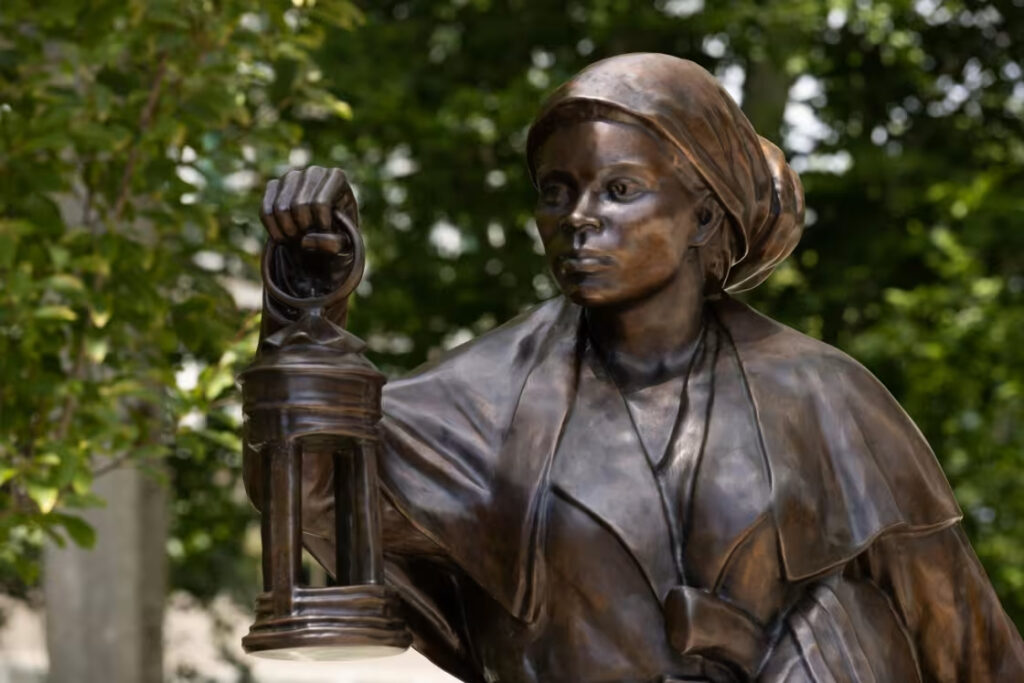The Prayers of Harriet Tubman

“As I lay so sick on my bed, from Christmas till March, I was always praying for poor ole master. ‘Pears like I didn’t do nothing but pray for ole master.’” There were persistent rumors that Brodess (her enslaver), who was again in debt, intended to sell off more slaves. Harriet spoke to God, she said, “as a man talketh with his friend,” and she began praying that Brodess would repent: “I groaned and prayed for old master: ‘Oh Lord, convert master! Oh Lord, change that man’s heart!”
She said later: “I prayed all night long for my master till the first of March; and all the time he was bringing people to look at me and trying to sell me.” When it appeared as though a sale was being concluded, Tubman changed her prayer: “First of March I began to pray, “Oh, Lord, if you ain’t going to change that man’s heart, kill him, Lord, and take him out of the way.”
Faith, spirituality, self-determination, vision, these were the gifts of Harriet!
From childhood to adulthood, as she blended the indigenous mystical traditions passed down through her African ancestors with the traditions of her beloved African Methodist Episcopal (AME) Church. Harriet Tubman’s spiritual journey throughout her long life led to her becoming — and making her worthy of the title — “mystic.” There are hardly any Black Americans formally named as mystics, but a few across history include: Sojourner Truth, Jarena Lee, Zora Neal Hurston, Toni Morrison, Alice Walker, Howard Thurman, Martin Luther King Jr., Jeremiah Wright, William Barber, Tracy Blackman, and I am sure a host of unnamed others.
None, however, merit the title more than Mama Harriet, deserving recognition as among the greatest of mystics. Her voice continues to speak afresh to those enslaved by systems, cultures, and ideas that block us from recognizing the divine image within us. Harriet still has the power to lead us to freedom. She is still praying….
Many books tell Harriet Tubman’s story of enslavement, which led her to become a renowned conductor of the Underground Railroad, freeing hundreds and never losing one. I believe that at the core of Harriet’s being—the public mystic who found her internal and emotional emancipation through a deep relationship with the Divine—was her self-determination and her prayer life.
Some associate the word “public” with fame, intellect, or political acumen. But the term “public mystic” for Harriet speaks to her embrace of the idea in indigenous African spirituality that giving to one’s community is a public spiritual act. In this understanding, Mama Harriet is as much a public mystic as she is a Black female conductor on the Underground Railroad and a Union soldier, spy, and healer during the Civil War, finding opportunities to free three hundred relatives and others sold farther south. A woman of deep faith, deeply connected to her ancestors – no more than twice removed from the Africans brought through the Middle Passage – she embraced the mystical and the indigenous belief that her prayers and her gifts were for her community. She focused on her duty to give them the same freedom she had won in the framework of African mysticism, which puts the social order at the forefront of Divine concern.
Many people feel that they remain in bondage to systems and structures and people. So, Harriet’s story – a small woman known as “Minty” as a child, who struggled with the effects of a brain injury after stepping between a young slave and his overseer, who embraced the mystical, who listened to the sound of the genuine in herself and led the way to freedom – can inform us in our present trek to freedom.
Evelyn Underhill writes that physical disturbances often accompany mystical experience. This reality is little understood or acknowledged today. St. Teresa of Avila has been called the “patron saint of hysterics,” and St. Paul deemed as an epileptic. St. Hildegard suffered migraine headaches, and Plotinus, St. Bernard, Saint Catherine, St. John of the Cross, and the Sufi poets Jàmi’ and Rūmī all suffered from bad health. Underhill writes:
“Their mystical activities have generally reacted upon their bodies in a definite and special way; producing in several cases a particular kind of illness and physical disability… caused by the immense strain which exalted spirit puts upon a body.”
Tubman’s fluttering heart always notified her when someone or something was a threat. She believed these physical symptoms to be messages from God. Perhaps it is time to honor this remarkable woman as Great Mystic.
“I’m gonna hold steady on You, an’ You’ve gotta see me through.” ~Harriet Tubman

Thank you so much for this insightful essay, Therese. Especially for reminding us that Harriet Tubman was indeed a mystic at all times, in her action as well as her prayer.
E
I think i missed where I was suppose to comment.
Thank you for your lovely and articulate article. Yes, indeed Harriet was surely a mystic.
Such an amazing woman. Cant wait to see her acknowledged and honored more.
She was a member of the African Methodist Episcopal Zion Church, where she left her property in Auburn, NY to the denomination.